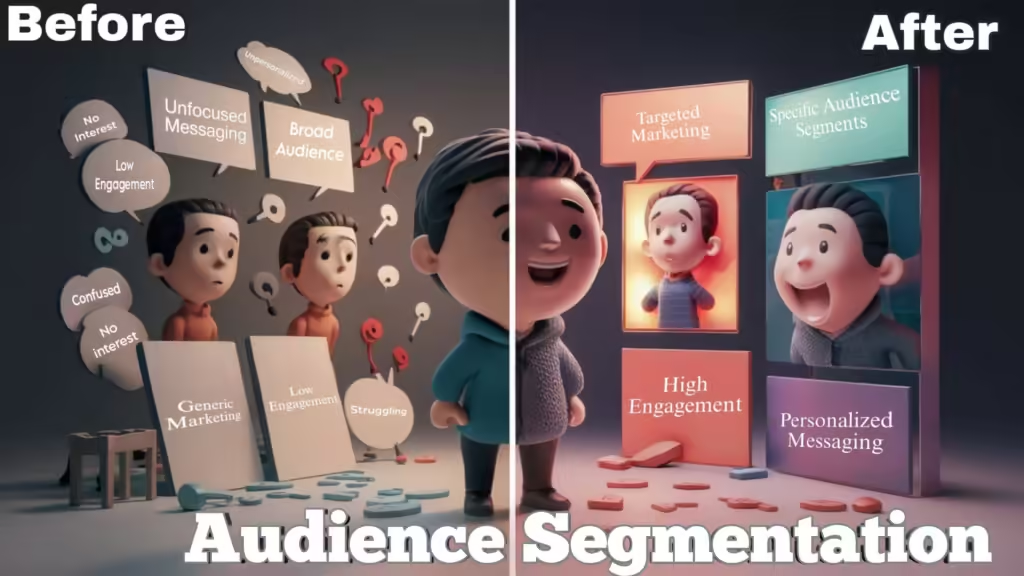To beat the competitive market of today, it becomes very important for businesses to know their audience. By knowing your audience and segmenting it into several groups based on their personal interests and requirements can target the audience more effectively. You may learn about audience segmentation in this blog post, which will cover its fundamentals, significance, types, and tools for doing it successfully.
What is Audience Segmentation?
Audience Segmentation involves division of a large consumer base into small subgroups based on their personal interests, browsing pattern, location, behavior, etc.
This procedure helps brands to target audiences and practice focused marketing strategies.

Why is Audience Segmentation Important?
The procedure of audience segmentation is important because it enables businesses to:-
– better understand their marketing strategies and target specific audience.
– this can engage more customers by delivering personalized contents as per their needs and interests.
– this can also increase conversion rates of the company by focusing the specific requirements of each group.
– it can optimize resource allocation by targeting efforts on high-value segments.
Types of Audience Segmentation
Demographic Segmentation
Demographic segmentation divides the market based on variables such as age, gender, income, education, and occupation. This type of segmentation helps businesses tailor their products and marketing efforts to meet the specific needs of different demographic groups.
Example: A luxury watch brand targeting professionals aged 30-50 with an annual income above $100,000.
Geographic Segmentation
Geographic segmentation involves dividing the market based on geographic areas such as countries, states, regions, or cities. This type of segmentation is useful for businesses that operate in multiple locations and need to customize their marketing strategies based on regional preferences and conditions.
Example: A surfboard company targeting coastal regions where surfing is a popular activity.
Psychographic Segmentation
It is a type of segmentation which involves deeply studying and dividing your audience on the basis of their buying behavior and their common interests.
It involves understanding the thoughts of the customer about their purchase preferences.
Example: Herbalife a fitness targeting company would target customers who focus on active and healthy lifestyles.
Behavioral Segmentation
It is a process of sorting your audience on the basis of their behavior like their browsing pattern, brand interest, purchase frequency, etc. This involves turning your users into your customers.
Example: An e-commerce site offering special discounts to frequent buyers or those who abandoned their shopping carts.
Steps to Effective Audience Segmentation
1. Conduct Market Research: For better understanding of your target audience conduct research and gather information using surveys, interviews and analysis.
2. Identify Segmentation Criteria: It becomes very important to identify what criteria brands should use for their business goals and nature of the market.
3. Segment Your Audience: Basically what brands should do is divide their audience into different groups on the basis of few pre-defined criteria.
4. Analyze Segments: It becomes very important to analyze the characteristics and requirements of each subgroup to better understand their real potential.
Tools for Audience Segmentation
– Google Analytics: It provides insights for website traffic and behavior of the users.
– HubSpot: This is a powerful platform which offers amazing tools for audience segmentation and practicing personalized marketing.
Offers tools for customer segmentation and personalized marketing.
– SurveyMonkey: This tool can help you to create surveys to collect information about your customer preferences and their behaviors.
– Mailchimp: It is a powerful tool for segmentation of the audience on the basis of email campaigns.
Conclusion
Audience Segmentation is the art of dividing and understanding your audience as per your goals. It therefore becomes important for companies to perform this with careful observations and details, otherwise companies can face the risk of developing a broad audience with no potential customers.
FAQs
What are the benefits of Audience Segmentation?
Audience Segmentation can provide enhanced personalized content, provide customer retention, cost efficiency, better product development and can provide competitive advantage.
What is the basic concept of Audience Segmentation?
The basic concept of Audience Segmentation involves division of the audience on the basis of their demography, geography, psychography, behavior, etc.
What tools can be used for Audience Segmentation?
Google Analytics, MailChimp, Hubspot, CRM systems, survey monkey and social media insights can be used for audience segmentation.
What are the 7 steps in the segmentation process?
The basic steps in audience segmentation include: conduct market research, identify segmentation criteria, segment your audience, analyze segments, develop targeted strategies, leverage data analytics and test and optimize.
This blog will guide you in understanding and perform better audience segmentation practices to boost your brand’s growth.
If you found this post then don’t forget to share this on your social media and with your posts.
Best of luck reader…..


